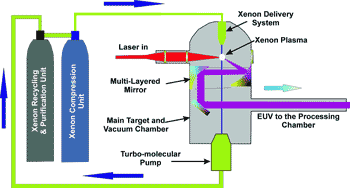Nozzle Design for Extreme Ultraviolet (EUV) Light Source
A CPU has over a 100 million transistors and this is increasing by 55% each year. By 2008, it is predicted that each CPU will have over a billion transistors. This forecast cannot be achieved with current lithographic techniques. Extreme Ultraviolet lithography could be the way forward.
Aims
To achieve this task, a new lithography source of much shorter wavelength is required. EUV lithography has significant potential. However, a reliable EUV source is required. This project seeks to develop a reliable, high power, laser-plasma generated EUV light source. The specific objectives are:
- the design and development of a nozzle assembly
- numerical design of a xenon supersonic nozzle for a vacuum condition
- validation of design using optical flow visualisation
- experimental study of laser gas jet interaction
- laser plasma diognostics
Applications
The benefits of low-cost EUV technology is not restricted to the semiconductor industry. The possibility of focusing reliable, high-power EUV radiation to unattainable spot sizes and short pulse durations has wider applications. These include surface, chemical and material dynamic studies, EUV non-linear optics, biological studies and a new generation of nanotechnology manufacturing tools and devices.
Results
To generate the necessary EUV power from laser-plasma interaction, a xenon gas density of 1018 cm-3 is required. A sonic nozzle generated gas jet can achieve the desired gas density. However the high-density region of the gas jet is very close to the nozzle exit. With plasma temperatures exceeding 103 0K, nozzle surface vaporisation and damage to the Bragg optics will occur. Supersonic nozzles avoid these problems by containing the high-density region of the gas jet away from the nozzle exit. However, the exact nozzle profile is extremely large, making it difficult and expensive to produce.
A novel approach to nozzle design has been established which satisfies all the EUV criteria.
 |
|
EUV schematic apparatus |
Future work
The next stage of this programme will involve nozzle construction and design validation using optical flow visualisation techniques. Experimentation will involve laser-gas jet interaction studies and measurement of absolute EUV power output using flying circus optics and plasma imaging and diagnostics using an X-ray pin hole camera technology.
Collaborators
Powerlase
Researchers
A. Khan
Funding
Duration
2004 - 2005









